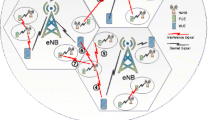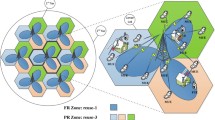Abstract
The latest evolution of cellular network, i.e., the heterogeneous network (HetNet) is a promising technique for facing the explosive data demands that the macro-only network can barely meet. However, unplanned small cell deployments, along with an aggressive frequency reuse scheme, generate severe interference between adjacent cells, degrading system performance. In the conventional homogeneous network, fractional power control (FPC), which consists of open-loop power control (OL-PC) and closed-loop power control (CL-PC), is used to determine adequate transmit power of user equipment (UE) to avoid inter-cell interference. However, setting the UE transmit power requires delicate awareness of uplink interference to properly avoid the severe and complicated inter-cell interference in an uplink HetNet environment. In this paper, we propose an interference-aware uplink power control scheme that considers outgoing and incoming interference in each cell in order to fully take the interference situation of the HetNet into account while setting the OL-PC parameter. By using the proposed scheme, uplink interference existing in a HetNet environment can evidently be reduced; therefore, the total cell capacity of both the macro- and the femtocell is increased by 25.6 %. Furthermore, the simulation results of a CL-PC on a 10 ms basis show that the received signal to interference-plus-noise ratio (SINR) of OL-PC with CL-PC is spread less around the target SINR compared to the case of OL-PC alone. Therefore, it is verified that the CL-PC supports the received SINR of OL-PC to meet the target SINR by compensating the channel variation caused by the fading effect.







Similar content being viewed by others
References
Muhammad, B., & Mohammed, A. (2010). Uplink closed loop power control for LTE system. In Proceedings of the international conference on emerging technologies (ICET) (pp. 88–93).
Deb, S., & Monogioudis, P. (2015). Learning-based uplink interference management in 4G LTE cellular systems. IEEE/ACM Transaction on Networking, 23(2), 398–411.
Simonsson, A., & Furuskar, A. (2008). Uplink power control in LTE overview and performance. In Proceedings of IEEE vehicular technology conference (VTC) (pp. 1–5).
Castellanos, C. U., et al. (2008). Performance of uplink fractional power control in UTRAN LTE. In Proceedings of IEEE vehicular technology conference (VTC) (pp. 2517–2521).
Muller, R., et al. (2009) Contrasting open-loop and closed-loop power control performance in UTRAN LTE uplink by UE trace analysis. In Proceedings of IEEE communications conference (pp. 1–6).
3GPP. (2015). Technical specification group radio access network; Evolved universal terrestrial radio access network (E-UTRAN); X2 application protocol (X2AP), 3GPP TS 36.423.
Castellanos, C. U., et al. (2008). Uplink interference control in UTRAN LTE based on the overload indicator. In Proceedings of IEEE vehicular technology conference (VTC) (pp. 1–5).
Gora, J., et al. (2010). Cell-specific uplink power control for heterogeneous networks in LTE. In Proceedings of IEEE vehicular technology conference (VTC) (pp. 1–5).
Safjan, K., & Strzyz, S. (2013) Open loop power control parameter settings impact on LTE HetNet uplink performance. In Proceedings of the international workshop on small cell wireless networks (SmallNets) (pp. 1134–1138).
Morita, M., Nobukiyo, T., & Hamabe, K. (2012). Uplink power control method for LTE femtocells based on resource usage aggregation. In Proceedings of IEEE Personal Indoor and Mobile Radio Communications (PIMRC) (pp. 442–447).
Ahmad, I., Kaleem, Z., & Chang, K. H. (2014). QoS priority based femtocell user power control for interference mitigation in 3GPP LTE-A HetNet. Journal on Korean Institute Communications and Information Science (J-KICS), 39(2), 61–74.
Kaleem, Z., Hui, B., & Chang, K. H. (2014). QoS priority based dynamic frequency band allocation algorithm for load balancing and interference avoidance in 3GPP LTE HetNet. EURASIP Journal on Wireless Communications and Networking (JWCN), 2014(185), 1–18.
3GPP. (2009). Evolved universal terrestrial radio access (E-UTRA); Radio frequency (RF) System scenarios (release 8), 3GPP TR 36.942.
3GPP. (2009). R4-092042: Simulation assumptions and parameters for FDD HeNB RF requirements, in 3GPP TSG RAN WG4 Meeting 51.
Technical clarifications of recommendation ITU-R M.1225, Guidelines for evaluation of radio transmission technologies for IMT-2000, Tech. Rep. 1997.
3GPP. (2014). Evolved universal terrestrial radio access (E-UTRA); Physical layer procedures, 3GPP TS 36.213.
3GPP. (2013). Evolved universal terrestrial radio access (E-UTRA); Radio resource control (RRC); Protocol specification, 3GPP TS 36.331.
3GPP. (2015). Evolved universal terrestrial radio access (E-UTRA); Physical layer; Measurements, 3GPP TS 36.214.
Kim, W., Kaleem, Z., & Chang, K. H. (2015). UE-specific interference-aware open-loop power control in 3GPP LTE-A uplink HetNet. In Proceedings of the conference on ubiquitous and future networks (ICUFN) (pp. 682–684).
Tejaswi, E., & Suresh, B. (2013). Survey of power control schemes for LTE uplink. International Journal of Computer Science and Information Technologies (IJCSIT), 4(2), 369–373.
Acknowledgments
This research was supported by the Industrial Strategic Technology Development Program of MSIP/IITP, Republic of Korea. (R0101-15-0057, Development of small cell base station supporting IMT-Advanced TDD radio technology for evolution of TDD network). This research was also a part of the project titled ‘Development of Distributed Underwater Monitoring & Control Networks,’ funded by the Ministry of Oceans and Fisheries, Korea.
Author information
Authors and Affiliations
Corresponding author
Additional information
English reviewed by NURISCO (Web: www.nurisco.com).
Rights and permissions
About this article
Cite this article
Kim, W., Kaleem, Z. & Chang, K. Interference-Aware Uplink Power Control in 3GPP LTE-A HetNet. Wireless Pers Commun 94, 1057–1071 (2017). https://doi.org/10.1007/s11277-016-3669-y
Published:
Issue Date:
DOI: https://doi.org/10.1007/s11277-016-3669-y




